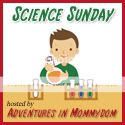As we sat yesterday and watched as the rain fell and examined the clouds in the sky, I remembered making clouds with Selena in this post. I thought it would be fun to revisit this fun experiment again. This time though I wanted to get more meat into our experiment. With a quick google search I found this nice child friendly site that explains very simply all about clouds.
We again went to the window after reading why clouds look white and at times look dark. As you can see from the picture above we had a good cloudy day to examine that the thin parts of the clouds reflected more light, hence making them look white, while the heavier clouds did not reflect as much light, hence making them look dark.
We discussed what elements we need for clouds to form. We first had to think about the air, in the summer when the air is warmer we see fewer clouds, while in the winter when the air is cooler we see a lot more clouds. Selena quickly caught on that we need cool air to make clouds…but why? As we read on we discovered that the colder the air, the more the vapors collect together, some freezing, the more the small particles of vapor and ice, they start collecting together to form clouds.
We also discussed what element we needed here on earth to make clouds and Selena quickly was able to answer water, such as the ocean. I showed her how the vapors were rising up today from the near by river to help form our clouds.
We then took our science into the kitchen. The supplies we used were the stove, my large soup pot filled with water, a pie tin and ice. After bringing the pot of water to boil, we tried to make clouds with the pie tin.
Selena quickly discovered that nothing was happening. I handed her the pie tin to examine. She quickly determined it was warm and we needed something to make it cold.
Now with our cold air mass, or the ice in the pie tin we began our experiment again. I must admit when we did this a few years ago we did get better results in the cloud formation on the bottom of the tin, but this time we got better results in the rain part. I am guessing this must have something to do with the fact that it is raining here now, where it probably wasn’t the first time we did this experiment.
In conclusion, Selena now understands that we need a water source, which is warmer then the air, a cold front or cooler air in the sky, to create the water vapor that forms small droplets that gather together the colder they get. The more the droplets, the heavier the cloud, forming rain. She also got a great lesson in how everything reflects light, but depending upon the properties of an object determines if it is a certain color or not such as white or black.










Great lesson! I like how you connected nature observations with this experiment.
ReplyDeleteSo, I forget, what's your thoughts on pinning your posts? Because I love how you applied all of this and extended from the first time you did it.
ReplyDeleteThanks for linking up to Science Sunday!